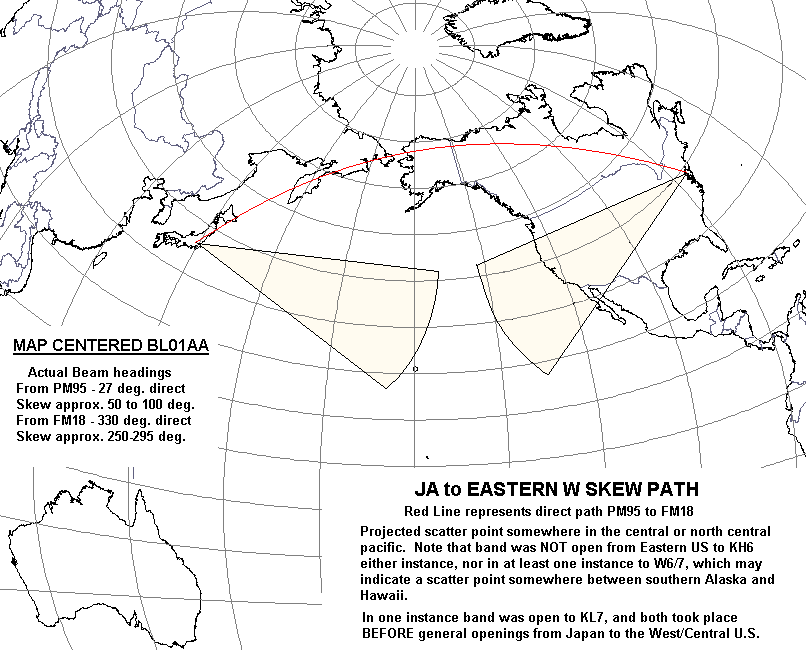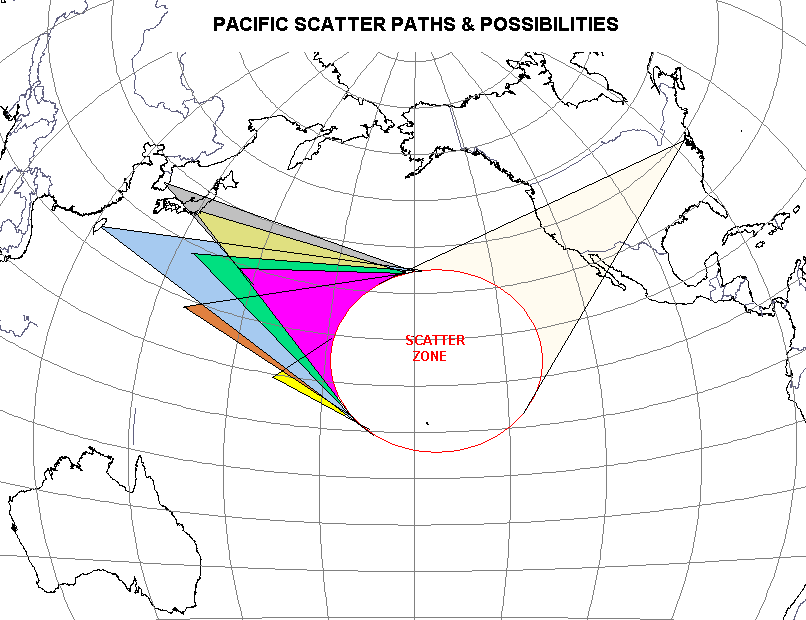Japan & the Pacific Beaming KH6 | |||||
| If there is any location in the world where working long range DX on the skew path is well-understood, it would be in Japan. Over the last two cycles well-equiped Japanese stations have worked into Finland, Europe, the Indian Ocean region and Asia on skew, and during the last cycle, the Eastern United States as well. (See an excellent article on the subject by JF3GPS) To my knowledge no skew path contacts between Japan and the Eastern US were made this cycle, but Japanese stations were at least heard on the skew path in both 2000 and 2001. During an opening from Japan to the West Coast of the United States in the fall of 2000 I was attempting to hear signals from American stations on .110 facing just a bit North of due West when I copied a JA calling CQ ("cq cq cq de JA6.."). Too much cq & too little call I'm afraid, but the signal was a very good 559 from the first cq till it rather abruptly disappeared. My impression at the time was that the station was calling while turning its beam, though I could be mistaken. I called CQ for a short time thereafter with 100w to no avail. Though it was not known to me at the time, this path had been worked by US stations and JAs last cycle, but conditions in the current cycle lead most to believe the path would be fruitless. During November of 2001, the scatter path was also open at least once to W1/2 from JA. In a backscatter QSO during the fantastic F2 season just past, K3KYR in Northern New York told me he heard a JA CQing along this path. Jeff had two antennas listening in relevent directions at the time, one beaming direct to JA over Alaska, and a smaller beam which was pointed to W6. He had full copy on the JA station, and (naturally) answered the CQ using the beam pointed on the direct path. Frustratingly, the signals died out before he realized that the smaller beam on the skew path had been the only antenna pointed in the correct direction. 
Based on the foregoing and a few other incidents I believe these paths will produce results early, before a direct opening from Japan to W6/7 or VE7. I notice that as the local afternoon progresses here, single hop F2 openings to W6/7 and VE7 progressively lengthen until no more stations are heard. In most instances the last stations heard are those farthest away from me, and thus I suspect that it is not a loss of F2 layer propagation I am experiencing, but rather a lengthening of the effective one-hop range of the F2 layer at 50 MHz. In effect, as local evening progresses signals from the West are passing over my head into the Atlantic Ocean, and mine are doing the same, passing over the West coast and coming down somewhere in the Pacific. Given good early morning conditions in Japan and continuing late evening (local) F2 propagation on the East coast, it may be possible for stations from each to reach a useable common scatter point over the Pacific before the East Coast loses propagation completely. Also, a long hop on the in-bound U.S. side of the path from the scatter point could explain why no propagation would yet exist to the Western U.S. and Canada. Aside from what appears to be the potential for early development, a big benefit of this path is an oceanic "skip" point, something far less likely on the direct path over the arctic. | Not surprisingly, this path could also be productive for East Coast stations with other Pacific entities as well. In October of 2000 I heard V73AT rather strongly on a path slightly more southerly than the JA path at about 260 degrees. I heard the same station again weakly on the same path during the fall of 2001. Given these observations and the geography of the region I think it is likely that scatter paths could also work between the Eastern U.S. & KH7K, KH4, KH9, KH0, JD1 and KH2, and with exceptional conditions, with Korea and even Taiwan. All of the paths discussed here will likely only work during local fall and winter of peak year of the solar cycle. Having very high solar numbers may not matter as much as one might think, however, for during the fall of 2000 when I heard JA & V7 SFI numbers were little higher on average than 160. 
Keep in mind that for the most part these are projected paths. Only V7 & JA were actually heard here, though I suspect for many of the other areas this may be more related to a lack of activity than a complete lack of propagation. Good gear and high power are also likely necessary under all but the best of conditions. No beacons or other propagation indicators are likely to be found along this path, with the exception perhaps of 49.750 video from Japan. Repeated CQing under promising conditions may in fact be the only way to discover extant propagation.
|
|
© David H. Craig 2002 |